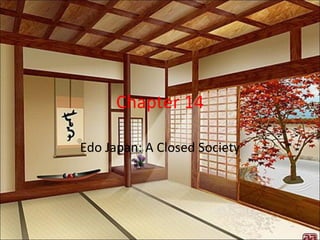Report
Share

Recommended
More Related Content
What's hot
What's hot (20)
HISTORY YEAR 9: BRITISH SOVEREIGNTY AND INTERVENTION

HISTORY YEAR 9: BRITISH SOVEREIGNTY AND INTERVENTION
Similar to Japan chapter 14
Similar to Japan chapter 14 (20)
Imperialism and industrialization in japan and china

Imperialism and industrialization in japan and china
More from mstraile
More from mstraile (15)
Recently uploaded
Discover the wonders of the Wenatchee River with a variety of river tours in Monitor, WA. Whether you're seeking thrilling whitewater rafting, peaceful kayaking, family-friendly float trips, or scenic sunset cruises, there's something for everyone. Enjoy fishing, wildlife spotting, bird watching, and more in this beautiful natural setting, perfect for outdoor enthusiasts and families alike.Paddle, Float, and Explore The Ultimate River Tour Experience in Monitor, WA

Paddle, Float, and Explore The Ultimate River Tour Experience in Monitor, WARiver Recreation - Washington Whitewater Rafting
Recently uploaded (13)
TRAVEL TO MT. RWENZORI NATIONAL PARK WITH NILE ABENTEUER SAFARIS.docx

TRAVEL TO MT. RWENZORI NATIONAL PARK WITH NILE ABENTEUER SAFARIS.docx
Exploring Heritage The Ultimate Cultural Tour in Palmer, Puerto Rico

Exploring Heritage The Ultimate Cultural Tour in Palmer, Puerto Rico
Hunza Cherry Blossom tour 2025- Hunza Adventure Tours

Hunza Cherry Blossom tour 2025- Hunza Adventure Tours
Understanding the Running Costs of Electric Scooters.pptx

Understanding the Running Costs of Electric Scooters.pptx
Exploring Montreal's Artistic Heritage Top Art Galleries and Museums to Visit

Exploring Montreal's Artistic Heritage Top Art Galleries and Museums to Visit
4 DAYS MASAI MARA WILDEBEEST MIGRATION SAFARI TOUR PACKAGE KENYA

4 DAYS MASAI MARA WILDEBEEST MIGRATION SAFARI TOUR PACKAGE KENYA
Paddle, Float, and Explore The Ultimate River Tour Experience in Monitor, WA

Paddle, Float, and Explore The Ultimate River Tour Experience in Monitor, WA
Agence Régionale du Tourisme Grand Est - brochure MICE 2024.pdf

Agence Régionale du Tourisme Grand Est - brochure MICE 2024.pdf
Japan chapter 14
- 1. Chapter 14 Edo Japan: A Closed Society
- 2. Japan and the Christians • In 1614 Ieyasu ordered all Christian missionaries to leave the country • Churches were destroyed and Japanese Christians who refused to give up their new faith were executed • This lasted until 1640
- 3. Terms of Exclusion Laws • All Christian missionaries and foreign traders were forced to leave Japan – No newcomers were allowed to enter • The Japanese could not leave their country, and if they did they would not be allowed to return • Ships large enough to make long voyages could not be built and existing ones were destroyed • Most foreign objects were forbidden
- 4. Exceptions to the Exclusion Laws • In 1639 the Shogun banned Portuguese ships in Japan and expelled all foreigners except for Dutch, Korean, and Chinese traders. • The Dutch were only allowed on a small island in the harbour of the city of Nagasaki • The Dutch were allowed to stay because they were seen as less threatening (they were interested in trade, not religion) • Some shogun also allowed Dutch scholars to teach them western medicine
- 5. The Booming Economy • Farmers increased production by irrigating and growing two crops on the same piece of land during one growing season • Road improvements financed by the daimyo helped increase trade • The population increased in urban centres • Silver and gold coins were introduced as currency
- 6. What held the economy back? • Minimal foreign trade • Overtaxing of peasants • Continued use of rice for payment in most transactions
- 7. The Age of Culture • Arts and culture were able to flourish because of the period of peace in Japan • Kabuki was the Japanese form of theatre which continued to grow because of the Japanese Isolation • With the isolation came a unique Japanese culture that was unaltered by western influences
- 8. The Floating Worlds • In these areas cultural activities like kabuki and noh (a musical dance) took place • The rules in this society were relaxed • These districts of Japan were kept under close surveillance by the shogun – The shogun viewed this as a waste of time, and they discouraged the samurai from taking part in these activities, but the samurai did so anyway
- 9. The Strong Winds of Change • Japan’s feudal system, which had been established by the shogun in times of conflict and poverty, was becoming outdated • More merchants were gaining wealth and power because more people needed their services • Many daimyo were nearing bankruptcy because of the alternate attendance system, and the costly road repairs • The people soon began to blame the shogun for their hardships
- 10. Disaster and Hard Times • In the late 1700s and early 1800s, Japan was struck by many natural disasters that brought about famines and took many lives • 1/3 of the Japanese population died of starvation • Rice became a scarce resource, and because of this the price increase drastically • The people felt that the shoguns response to these problems were ineffective – This led to an uprising that brought about the Meiji period
- 11. Expansionist threat from Outside • By the early 1800s, many countries wanted to trade with Japan, including: – Russia, England, and the United States • The reason the United states had an interest in Japan was because of their geography and economy